How to Build the Ultimate Tech Stack for Growth in 2021
There are now 8,000 martech tools available. Which ones should you choose? Our new guide will help you decide which ones are right for your business.
There are now 8,000 martech tools available. Which ones should you choose? Our new guide will help you decide which ones are right for your business.
Here’s a statistic for you: in 2021, a typical mid-market company uses 185 different apps in their tech stack.
If you see numbers like that and feel overwhelmed, you’re not alone. According to Gartner, technology sprawl is one of the top ten business challenges faced by businesses today.
Unless managed carefully, tech stack sprawl can be incredibly debilitating to an organization, leaving you with inefficient spending, siloed data, and substandard customer experiences.
So what can do you to build a technology stack with scalability in mind that doesn’t slow you down and lock you in? It starts with choosing a flexible system of technologies that doesn't compromise on functionality and can be swapped in and out as your business grows and your requirements change.
Segment solves this. It acts as a middle layer between your website or app and your tech stack. This gives marketers an edge: you can quickly improve your stack as new and better tools come out, or as your requirements change.
To share what we’ve learned over the years, we’ve put together a comprehensive guide to help to build a tech stack for growth in 2021.
Building a tech stack should start by answering two questions.
What does my customer journey look like?
What tools can help me optimize that customer journey more effectively?
Before you start building or revising your tech stack, there are four steps you need to take to understand your customer journey.
First, identify the overall stages your customers go through and why they go through them. This will start to give you an idea of where opportunities for improvement exist and how you might leverage them.
Here’s what a pretty common customer journey looks like:

With this mapped out, a few ideas for objectives may start to form. But at this point, they exist as set broad questions, like, “Where is our traffic coming from?” To take these from broad questions to specific objectives, we need to collect good data.
Good data collection is the fuel that drives your tech stack. It reveals what’s really going on in your customer journey by providing a clear and comprehensive picture of who your customers are and what they’re doing.
Google Analytics JavaScript snippets (i.e., bits of code embedded into the website) are often the go-to for collecting website usage data. These types of simple analytics tools are relatively easy to implement but don’t provide all that much insight into your customers or their behavior.
Two more advanced analytics calls will give you visibility into this:
Event calls collect data on which action occurred. In Segment, event calls are created with analytics.track and can be anything from a page view to a trial sign-up to a payment.
Identify calls collect data on who took that action. In Segment, identify calls are created with analytics.identify and can be IP addresses, email addresses, names, and more. All of this is then assigned to a unique ID.
These two calls together provide a persistent profile of who this user is and the actions they’ve taken to become your customer. Here’s an example of “usr_123” going through the stages of a simple customer journey:

In this code, you can see that “usr_123” signed up after landing on your site from an organic search. Later, they watch a video in the “Sports“ category and then upgrade their plan to “Professional,” which has monthly recurring revenue of $30. With advanced analytics, your picture of “usr_123“ and the actions they take is fairly comprehensive, and you can start to draw some conclusions about your customer journey.
But looking at code like this for every customer is not feasible. To actually use this data, you need to send it all into a set of analytics tools that can visualize it. Then, you can understand individual customer journeys, along with every customer journey in aggregate.
To make sense of your data, there are two categories of tools to choose from: specialized analytics tools and business intelligence tools. The purpose of these tools is to visualize the customer journey we mapped out earlier using real customer data.
If you want to perform specific types of analyses in your customer journey, you can send your data to specialized analytics tools, such as Google Analytics, Amplitude, and Mixpanel.
These tools are good for companies just starting out that don’t have the resources to delve deeply into mountains of data. As such, these tools can’t provide a complete picture of the overall customer journey but are great for their specific use cases.
Google Analytics is useful for ad hoc analyses and data exploration but are not the best for dashboarding and acting as your source of truth.
Amplitude and Mixpanel are good for funnel conversion and cohort analyses.
If you outgrow the capabilities of specialized analytics tools, you can power up your analytics by using data warehouses and business intelligence tools. Together, they can act as a source of truth, providing a complete understanding of your customer journey.
Data warehouses are central repositories for all your customer journey data. Some examples of data warehouses include:
Business intelligence tools sit atop data warehouses to visualize all your customer journey data. A few examples of business intelligence tools:
With your data collected and visualized, you can dive back into the questions you outlined when you initially mapped out your customer journey.
Answers to questions such as “Where our traffic is coming from?” will be relatively easy to find. From there, you can start to ask questions such as “Why is our traffic coming from there?” And deeper questions like that give rise to opportunities for improvement.
To grow, you need a well-oiled customer journey that takes people down the conversion funnel quickly and with some sense of regularity. Now that you have an understanding of what our customer journey looks like, you can see how it behaves. This will give rise to tough questions and help you identify hitches that slow or interrupt the customer journey.
For example, in this screenshot from Amplitude, we can see that only a small percentage of users shared a song or video after playing it.

Let’s say you identify that users who share a song or video are much more likely to convert later on. So getting users to share has become a North Star metric for you, and seeing this drop off may be a worrying sign.
Here, your top business objective at the moment would be to “increase the number of shares per song or video.” With that information, you can start to look at tools that encourage shares.
It gets even better if we use cohort analysis in Amplitude. Here’s a screenshot of how many app users drop off each day:
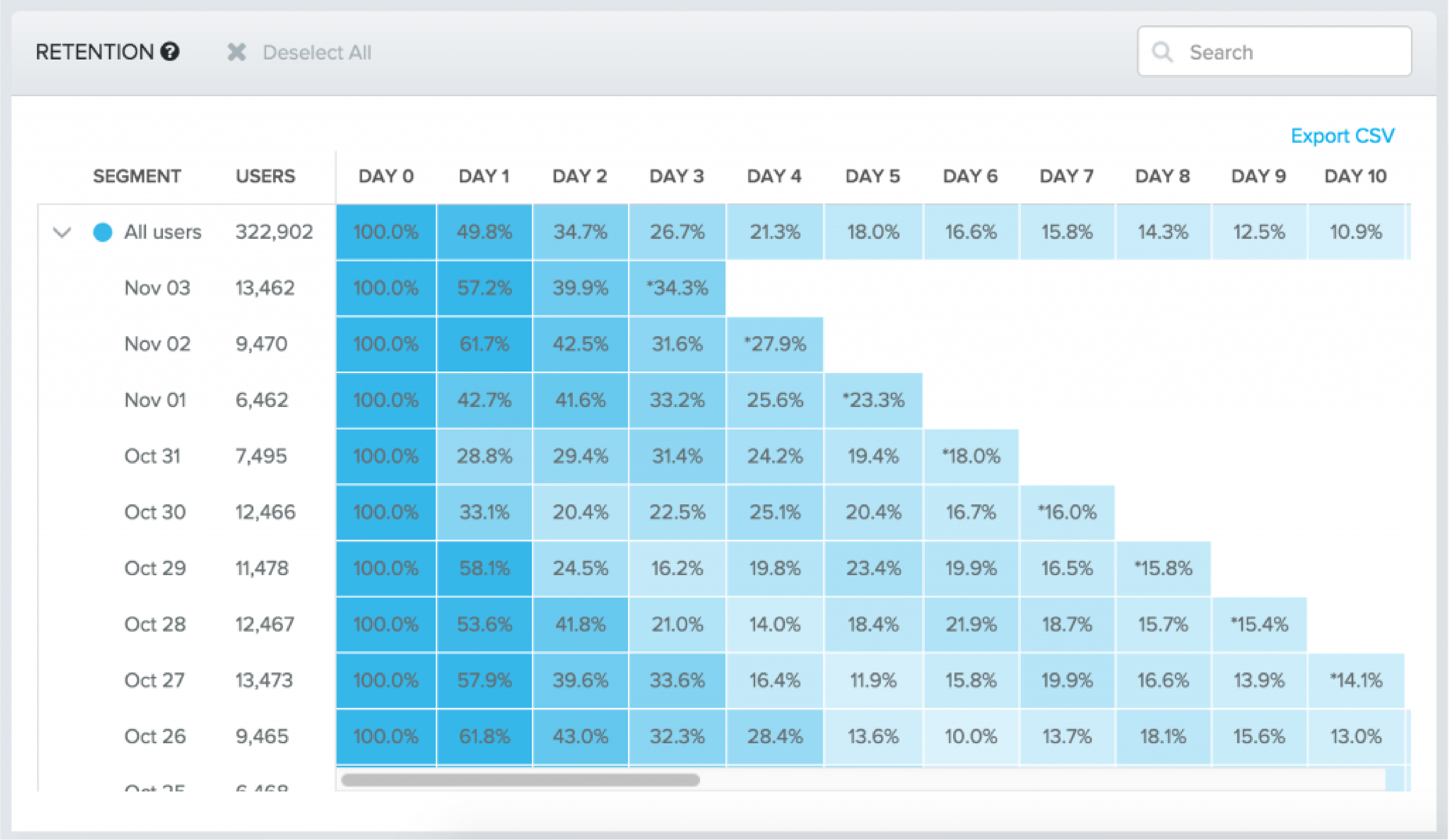
Here, you may identify that you need better engagement for users around Day 2 or 3. So maybe you’ll invest in a push-notification tool to keep users engaged longer. If you run an experiment with a new tool like that, you can then clearly see if it has had an effect.
This is what analytics provides — an understanding of the customer journey, how it can be optimized, and whether it’s improving.
Now that you have your analytics foundation providing an understanding of your customer journey, you can start to build your tech stack on top of it. We describe this as a “choose your own adventure” process because every company’s customer journey will reveal different opportunities.
Out of these opportunities will come laser-focused objectives that solve real problems that are affecting your company’s growth. So, back to our two-part question:
What’s my top business objective at the moment?
What tools can help me meet that objective faster and more effectively?
What tools you choose for your tech stack depends on the objectives you identify for each stage of the customer journey. We’ll take you through how we usually go about this process, along with some tools to consider.
Keep in mind, this is a strategy for building your tech stack, not a prescription for which tool to use.
We usually inspect engagement first, because low engagement among your current customers is often an indicator of poor retention. Any efforts to improve the rest of the journey may not be as effective, because if your customers aren’t sticking around, you’re filling a leaky bucket.
At the engagement stage, your business need may be “to grow the number of active users over a given amount of time” or “to increase the volume of content consumption within our product.” To achieve these kinds of objectives, here are four commonly used software categories.
Email and marketing automation tools
If you’re seeing a significant drop-off in usage, email, and marketing automation tools can nudge users to take action and pull them back into your product.
This example from Airbnb is effective because that big, bold zero reminds you that you’re not earning as much money as you could. So you hop back in the app to finish your hosting profile to start earning money.

A few email and marketing automation SaaS tools:
Mobile and push notifications
SMS and push notifications can solve the same problem email and marketing automation tools do, but for smartphones. Here is an example of a push notification from Netflix announcing a new season of Orange Is the New Black.

A few mobile and push notification tools:
In-product activation tools
You want your users to reach the all-important aha moment at the exact right time so they become customers for life. In-product activation tools specialize in exactly this. Grammarly’s product tour for new users is a good example.
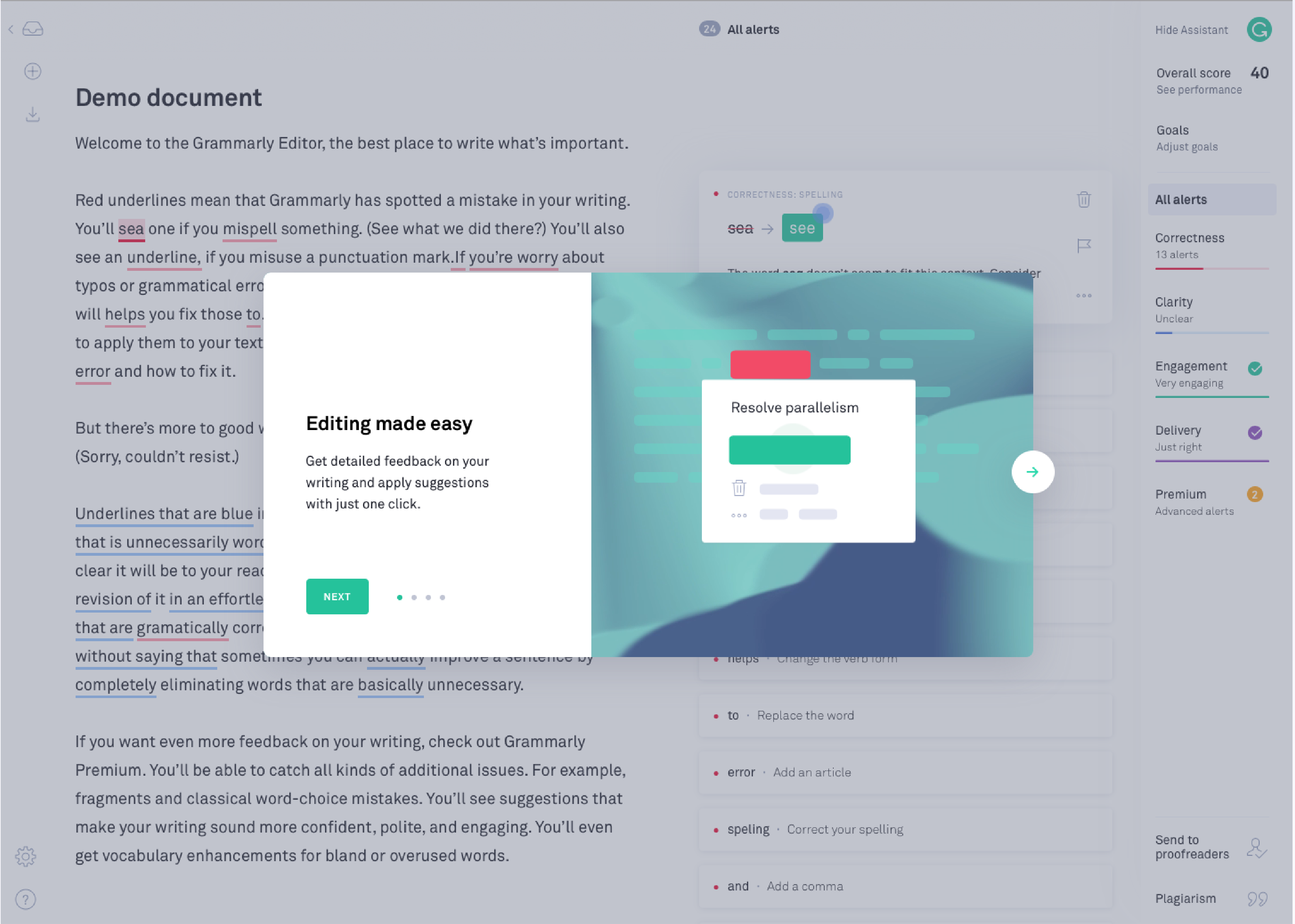
A few examples of in-product activation tools:
Live chat tools
The personal touch of live chat tools can establish trust and sow the seeds for a long-term relationship between you and your customer. For example, here’s a plant shop’s chatbot helping the user find exactly what they’re looking for in no time.

A few examples of live chat tools:
Once we have the leaky bucket fixed, we move up the funnel to make sure we’re filling it consistently by attracting enough attention and traffic.
In these stages of the funnel, your objective might be “to leverage a strong organic search presence to capture featured snippets” or “to test different messaging strategies based on transactional data.” Here are a few categories of tools to consider.
SEO, content, and referral tools (for earned traffic)
Earned traffic comes from good experiences, whether that's with your content or with your product. Invest in tools that help you leverage your positive encounters so your biggest fans can spread the word. This compounds over time to build a strong organic-search presence and word-of-mouth presence.
A few SEO, content, and referral tools:
Advertising platforms (for paid traffic)
Because pretty much the entire world is exposed to advertising, it’s often the first place people go when building out their tech stack for growth. One caveat we always mention is that advertising is most effective when you:
Know who your audience is
Know where they are (e.g., Facebook vs. LinkedIn)
Have a compelling, relevant offer
Otherwise, advertising can get costly and lose efficacy over time. So when evaluating advertising platforms, don’t ask, “Which one is best?” Instead ask, “Which platform allows me to reach my audience?”
A few examples of advertising platforms:
A/B testing and personalization tools
To grow, you need the traffic to convert. Personalization, when used well, is a great way to improve conversion rates.
Peerspace, for example, tailors three blocks on their home page to each visitor. First, their header image and copy change to match the visitor’s location (1). Then, they’ll change the brands they work with to match your company (2). They can even change the top benefits they list to match your use case (3).
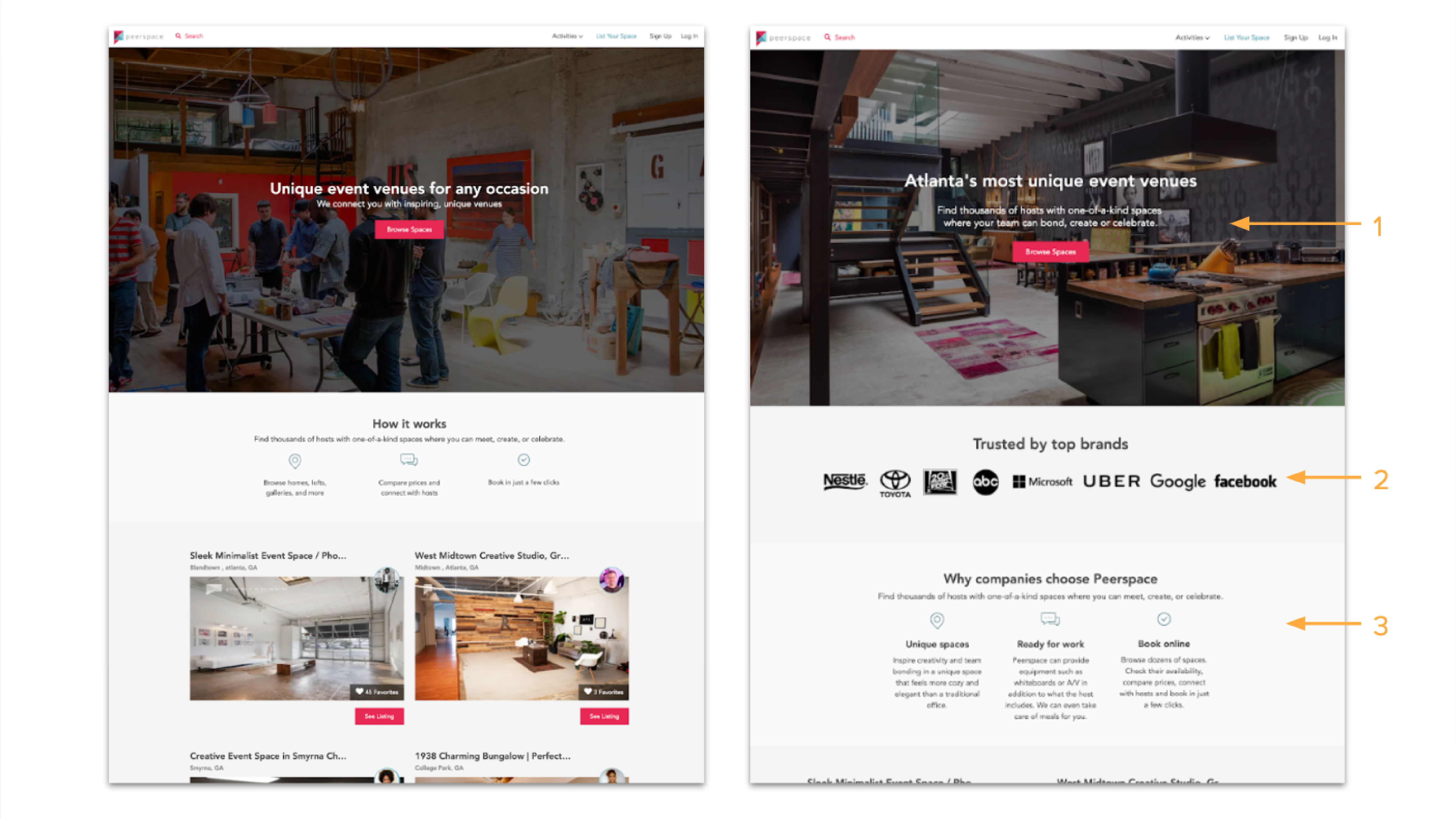
A few A/B testing and personalization tools:
Landing page tools and content management systems
Empowering your marketing team to make their own landing pages, websites, and blogs is an easy way to speed up their workflow (and make your developers’ lives much easier).
An example of this in action is our Resources page, which is a huge boon for both SEO and conversion rates. It’s almost completely managed by our marketing team.
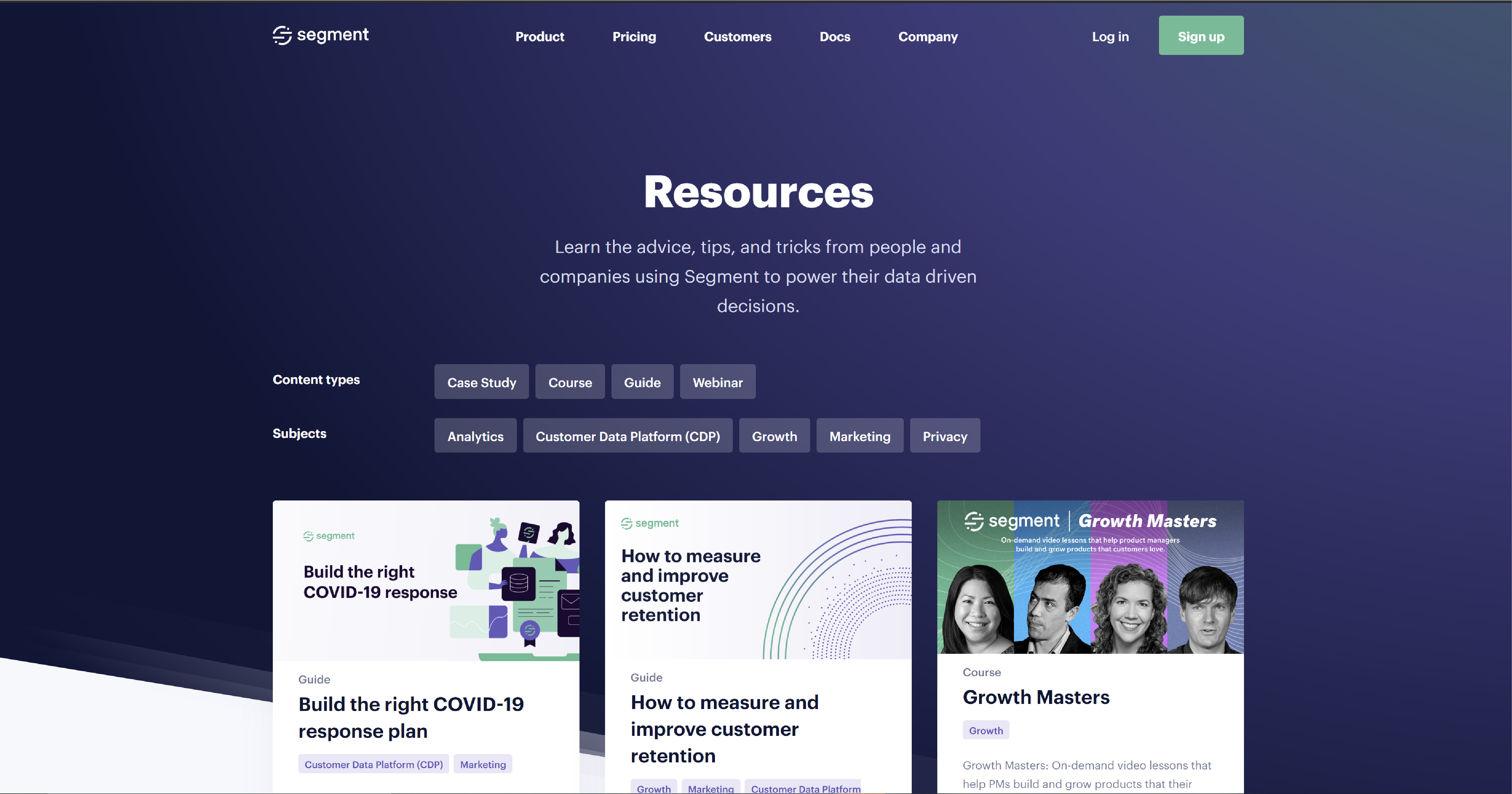
A few landing page tools and CMSs:
Finally, we turn to retention, which is essential for growth. Good retention means you’re providing a service or a product that people value. That goodwill compounds over time to improve all stages of the customer journey.
Again applying the first of our two core questions, the top business objective that your customer journey reveals might be “to reduce churn rate by a certain percentage“ or ”to speed up the time it takes to close a support ticket.“
Here are three software categories that can help with objectives regarding retention.
Customer relationship management (CRM) systems
Ultimately, retention depends on the relationship you build with your customers. Use a CRM to centralize customer communications and manage that relationship.
Here’s an example of a customer profile from HubSpot:

A few examples of CRMs:
Support tools and help desks
To retain customers, you need to keep them happy. Support tools and help desks help customers resolve issues. Of course, as you grow, keeping customers happy becomes more difficult. Invest in tools that match your scale.
A good example here is Vitally, which has a super-useful customer success dashboard:
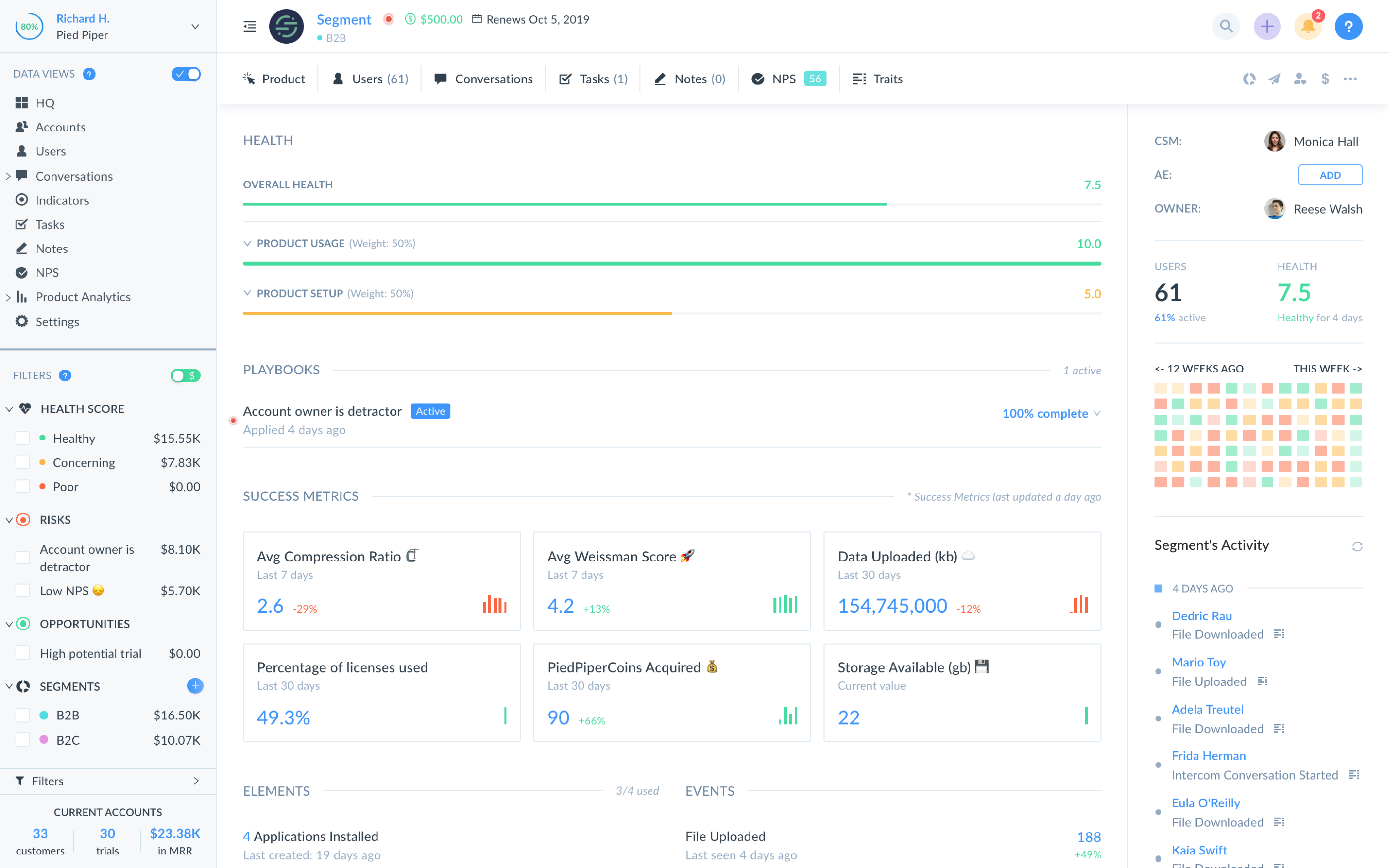
A few examples of support tools and help desks:
Payments
A big part of reducing churn is just making it easier for your customers to pay you. Payment processors will help you make this process painless and identify accounts at risk for churn.
Here is a payment dashboard from Stripe, which is our suggestion for payment processing:

Examples of payment tools:
Churn Buster (not a payment processor, but a good tool for recovering churn)
As you move forward into the process of building your tech stack, I’d like to call out four articles we wrote that can provide some more clarity into what your tech stack may look like and which specific tools our customers find useful:
The Growth Stacks of 2019, where we dive into which tools grew the fastest in their respective categories
The tools of today aren’t the tools of tomorrow, where we group different types of tech stacks into different themes (it’s one of my favorite articles we’ve done)
Choosing the Right Stack, where we dive deep into considerations to take into account when evaluating specific tools
How our stack evolved - Frame.io, where we explore how Frame.io built their tech stack over time
One final note, Segment helps companies of all kinds build and maintain their tech stacks, so if you’d like to get started, create a free account and we’ll help you get on your way.

Our annual look at how attitudes, preferences, and experiences with personalization have evolved over the past year.